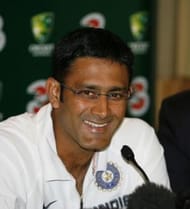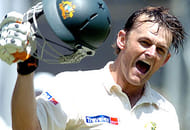The Chennai Super Kings have won the 2010 edition of the Champions League T20 but they would not want to celebrate the victory for long as five members from the team are required to be present in India in less than 24 hours. MS Dhoni, Suresh Raina, Murali Vijay, Michael Hussey and Doug Bollinger find themselves in a situation very similar to when they found themselves in after the Indian Premier League earlier this year. Like they were expected to fly to the Caribbean to join their International teammates for the World T20, this time they would have flown to India to gear themselves up for a Test series that is considered the next best only to the Ashes.
The Border-Gavaskar trophy has only been gaining importance with each passing edition. Achieving a series win in India was considered the “final frontier” by Steve Waugh himself. One reason is that Australia never used to tour India as frequently as they are doing now. The tour of 1986, when Steve Waugh had just entered the cricketing arena and when Dean Jones overcame the Chennai heat and dehydration to achieve the first ever tied Test in the history of the game, was the last series to be played before a gap of nearly ten years ensued.
Australia then returned to India in 1996 for a solitary Test, the one in which Nayan Mongia scored his maiden Test century and India went on to win (Dileep Premachandran calls it the Nayan Mongia Test). The lone Test was not much help to the Australians to adapt to the Indian conditions, a factor which came back to haunt them in 1998 when Mark Taylor’s men returned for a full tour and went back with a one-day trophy after losing the Test series 2-1.
Come 2001 and the boys under Mark Taylor were now becoming men under Steve Waugh. Waugh’s description of the “final frontier” was apt considering that his team had been on a roll since 1999, winning 15 Test matches in a row; a feat that began, ironically, with the team they were about to play. The mind games that Sourav Ganguly initiated, only pepped up the hype leading to the tournament. When India lost the Mumbai Test, it appeared Ganguly had spoken a bit too much when he said Australia had been playing only average sides in the previous two years. But in Kolkata and Chennai, VVS Laxman and Harbhajan Singh ensured that Waugh would have to wait for some time till the final frontier was conquered.
The next tour was in 2004 and a lot happened before this. Steve Waugh dropped out of ODI contention, announced retirement after the 2004 Sydney Test and Ricky Ponting took over as full time Test skipper. But an injury to him meant that Australia would go into the Test series under Adam Gilchrist’s captaincy. Michael Clarke’s 151 on debut at Bangalore helped Australia cruise home by 217 runs. The second Test at Chennai seemed to be going India’s way until rain intervened to wash out the final day. A seaming wicket at Nagpur was a bone of contention for the BCCI as it was believed the conditions were altered to snub Jagmohan Dalmiya, the then BCCI President.
Sourav Ganguly absented himself from playing, Yuvraj Singh‘s fall from grace all went on to ensure that Australia finally conquered the final frontier under Adam Gilchrist.
The job is not over even after you reach the top. You need to sustain your position there. Ricky Ponting has the responsibility of doing just that. While he would have definitely felt happy for Gilchrist’s achievement, there is no denying that he himself would have loved to be part of it. Which is why the 2008 Test series was of paramount importance to him. It was a phase when both teams had a lot of similarities. Sourav Ganguly’s position in the team was constantly under doubt and Matthew Hayden’s loss of form after the IPL raised questions about his commitment to the baggy green.
Anil Kumble explicitly stated that the Bangalore Test was his last and India now had to find a deputy for Harbhajan Singh. Parallely in the Aussie camp, the search for Shane Warne’s successor seemed a never ending exercise. While India seemed to have found an answer in Amit Mishra, Australia settled for Cameron White and Jason Krejza, both of whom had mixed fortunes throughout the tour and they never got to wear the baggy green after that till date.
A 2-0 loss meant Ricky Ponting would have to wait for some more time till he could personally be a part of the movement to sustain the final frontier.
“Some more time”, thankfully, did not turn out to be too long as the BCCI scrapped the originally scheduled 7-ODI series for 2010 and converted it into a 2-Test, 3-ODI tour.
Nathan Hauritz has risen in importance to become the prime spinner. The Shane Watson-Simon Katich opening pair is the second best only to Matthew Hayden-Justin Langer in terms of average runs scored. Brett Lee has retired from Tests but Doug Bollinger has already stepped in to his big shoes. Where Andrew Symonds was, we now have Marcus North. For India, Dhoni took over as full time Test captain immediately after the 2008 series. In Sourav Ganguly’s place is the young Suresh Raina, who has got the opportunity due to his 90-odd ODI appearances and a loss of form to Yuvraj Singh. Amit Mishra did not do much in Tests after 2008 and finds himself replaced by Pragyan Ojha who forms an ideal left-arm complement to Harbhajan Singh.
Michael Hussey responding to a question on the Test series after Chennai’s CLT20 win said that it is a test of mental turnaround because of the shift of focus from the shortest to the longest format. How effective is the turnaround, we will get to know three days later. Brace yourself up for some quality Test cricket action starting October 1.
Looking for fast live cricket scores? Download CricRocket and get fast score updates, top-notch commentary in-depth match stats & much more! 🚀☄️


